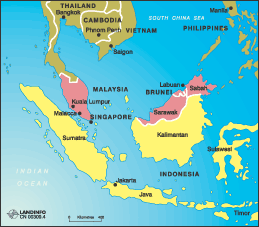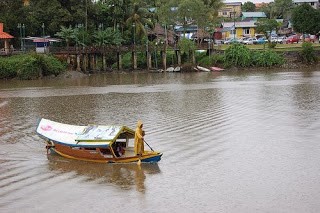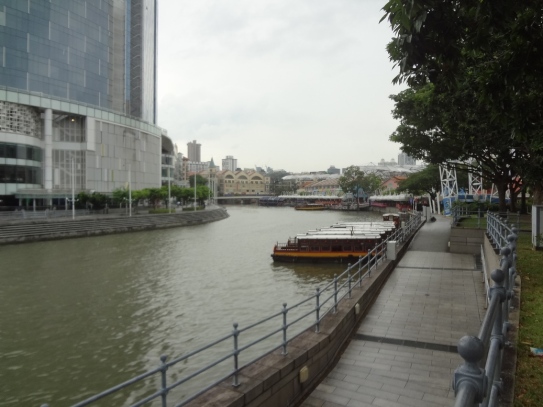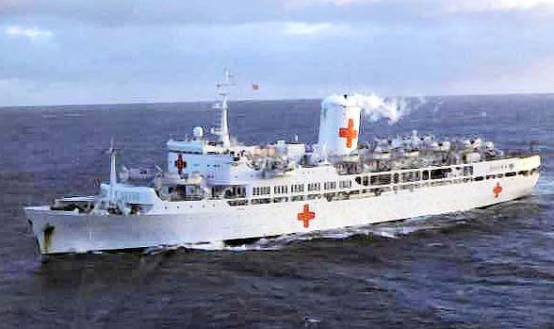
Just a little of the background to the ‘confrontation’, which was that Indonesia objected to the creation of Malaysia, and the inclusion of Malaya, Singapore, North Borneo, (which was a Crown colony), and Sarawak, which was known then as British Borneo, and is now known as East Malaysia. The pink bits on the map are the areas in question.
Borneo is the name of the large island, which is part yellow and part pink.

President Sukarno
President Sukarno argued that the country of Malaysia would be a British puppet state, a neo-colonial experiment, and that any expansion of Malaysia would increase British control over the region, with implications for Indonesia’s national security.
Similarly, the Philippines made a claim to eastern North Borneo, arguing that the Borneo colony had historic links with the Philippines through the Sulu archipelago.
In April of 1963 Indonesia used local militants, trained by the Indonesian army, to attack East Malaysia, north & south of Kuching in Sarawak . This act brought the British in to the conflict in defence of the new country. Later Indonesia committed regular troops to cross border attacks.
In 1964 Australia joined the British in defending Malaysia, and in 1965 New Zealand joined the Commonwealth forces.
Later in 1965 Indonesia sent raiders by boat in to the Malay Peninsula near Johor Bahru. They were rounded up by the Kiwis
.
Indonesia also dropped ninety six paratroopers using, three C130 Hercules, but due to a storm the troops were scattered over a large area. It took a month for a Gurkha regiment, and the Kiwis to capture or kill ninety of the paratroopers.
The conflict ended in August 1966 after Sukarno lost power to Suharto. Sukarno had taken his country down the path of communism, befriending China, Russia and Cuba.
……………………………………………………………………………………………………………………….
I was collected as promised and taken to join my new posting as Third Mate of LST Frederick Clover – she was built as LST 3001 in 1945, and renamed as Frederick Clover in 1946.

Her displacement was between 2,140 tons and 4,820 depending on her cargo. She was flat bottomed for landing tanks and heavy vehicles on beaches. She had bow doors and a ramp as well as a secondary ramp within the enclosed deck to the main open deck, for driving lighter vehicles up to the main deck.
The drawing makes her look attractive . . .

Real life . . .
I reported to the Captain, who was around thirty years of age.
He looked at my file and seemed quite pleased that he had an RNR officer on board. He’d always wanted to see if the oerlikon 20 mm AA gun on the forecastle would work, so he put me in charge of the AA gun.
The problem was, even though I was in the RNR, I’d never been trained in the use of a ship’s gun, because I’d spent all my time at sea on Company merchant ships.
When I visited the forecastle to acquaint myself with my new responsibilities I realised that if we had to defend ourselves we would have to ask the Indonesians to return later.

I saw something like this . . . . on the forecastle.
The barrel of our gun was still in its wooden box bolted to the deck! I opened the box to reveal a brand new barrel covered in wax paper and grease.

This is what I expected to see, or something similar . . . . .
I checked around and realised that we had another small problem – we didn’t have any ammunition!
I reported back to the Captain and told him of the barrel, and the lack of ammunition and (thankfully) he told me not to bother with the AA gun!
Afterwards I wondered if, perhaps the whole exercise had been a set up for the new 3rd Mate.
Frederick Clover was ‘old’, but even so I still had to sign the Official Secrets Act. Considering that she had been involved in the Korean War, as well as the creation of the State of Israel (1948), and possibly the Suez Crisis of 1956, I doubted that there was anything left of this LST of which a potential enemy would not be aware.
She had two engines and our maximum speed was under ten knots. I have seen Chinese junks, with a following wind, over take us, but that is a secret.
The bridge was open to the elements, and the most modern piece of equipment was a standard civilian RADAR system.

Yours truly in the Captain’s chair open to the elements, and a slightly protected area of the bridge for taking bearings – see below.

The following day we began loading troops and equipment for Borneo.

Army land rovers driving up the inner ramp from the tank deck to the main deck. We always put the lighter vehicles on the main top deck.

Loading ammunition and other supplies.

Sorry for the poor quality but I tried to capture the loading of heavy equipment, trucks and field guns via the bow ramp.
On one trip we’d been given special instructions to dump various secret cypher machines in the deepest part of the channel between Indonesia and Singapore, where the depth was over a mile deep.

The army did such a good packing job that the crates of secret machines floated away! We had to machine gun the boxes so as to allow them to sink. I had an army SLR (self-loading rifle) and it was good fun firing at the floating cases until they sank.

My SLR was similar to the above
For target practice the troops would blow up contraceptives and painting them any colour except blue, (due to the colour of the sea), before dropping them over the side to use them as targets.
I was also allowed to ‘have a go’ using an SLR and later a machine gun – ‘boys own’ comics come to life, but best of all the target didn’t return fire.
Over the months we did a number of runs to Borneo dropping off and picking up various troops in Kuching, Sibu, Labuan Island, Jesselton (now called Kota Kinabalu), Tawau,and Bandar Seri Begawan, which is on the island of Borneo, but not part of Malaysia, because it is the capital of the Sultanate of Brunei.

The green markings indicate the places that we visited, and the one on the right is Tawau
Life on the LST was some times boring and sometimes quite interesting. The steering gear breaking down as we approached Tawau was a tense time, Tawau being very close to the Indonesian border.
The area controlled by Indonesia is called Kalimantan.
Sailing up the rivers to Kuching or Sibu (the two green lines on the left) was like floating back in time with the sound of the jungle animals and birds, native river craft, (see below) and a pilot who could have stepped out of Joseph Conrad’s ‘Lord Jim’.

I took this photograph in 2017, but the boats haven’t changed since I first saw one in the 1960’s. Perhaps the adverts on the roof were the only changes.

The main deck fully loaded with the lighter vehicles, and each vehicle had its own load.
The deck cargo of instruments of war in a peaceful Sarawak river as we headed up river to Kuching. We were ‘dressed overall’ as this would be our last trip because the Frederick Clover was to be decommissioned and sold on our return to Singapore.

The army had their own small landing craft – I took the above when in Singapore Harbour.

Alongside in Kuching discharging the army’s supplies.
During my time in the Frederick Clover I was required to visit the seamen’s ‘pool’ in Singapore to replace crew members who had paid off and gone home. The seamen’s pool is where unemployed sailors registered their availability for work to the port authority. In today’s world there are a number of companies that specialise in the supply of seamen skilled in various duties. In the mid 60’s it was up to a particular ship to pick a crew from a ‘pool’ of sailors.
On this day I was sent to find four qualified sailors for our next run to Borneo. From memory I was presented with four lots of twelve men and was expected to be able to find the required number from these four groups. The four groups were a jumble of races; Europeans, Indians, Arabs, Chinese, Africans etc. Obviously I wanted English speaking men, but their race was immaterial.
Some were young, perhaps first or second trippers, others were quite old, and very experienced, but would they be fit enough in an emergency considering we would be in a ‘confrontation’ zone.
I found it to be a hard job to pick the right people consider that many had been looking for a berth for some months. Some had their discharge book, which gave me their history and previous captains’ comments. Others didn’t have any papers, but were very persuasive playing on my sympathy as they had been out of work for so long. I’d only just turned twenty two, and I wondered what the older men thought of one so young with the power to influence their lives.
If a seaman is discharged with DR in their discharge book (DR = Decline to report) this will guarantee they will not work again. I was looking for VG (Very Good) or G (Good), and a record of the ships and voyages. Those with DR would destroy their discharge books if they were unable to obtain a paper discharge.
A paper discharge was in place of their discharge book and of course they would destroy the paper discharge to keep themselves ‘clean’. I checked the time gaps between their signing on various ships allowing for leave time, but a long spell between one ship and another could indicate a DR, unless they had a very good reason for such a long gap.
I spoke to as many as I was allowed (I was followed by someone from the port authority) and eventually picked four and took them back to the ship, where they were signed on as sailors.
We did not supply uniforms on the LST, unlike the Company’s cargo vessels where a full crew could well have come from one village, and in this case the Company supplied them all with uniforms. For the villagers, it was considered a great honour to work for the Company and many spent their whole working life in the Company’s employ. I don’t know of anyone visiting a seaman’s pool looking for replacements on the Company’s vessels.
We never sailed in convoy, but independently as a normal merchant ship. Being the junior deck officer I was allocated the mid night to four am watch, and the midday to four pm watch – known as the graveyard watch.
One cloudy night around three in the morning I picked up a target on the radar and tried to find the target’s steaming lights so as to work out where she was and her course. We were showing our normal navigation lights, so why was this other ship blacked out? I watched it on the radar, and quickly worked out that she was closing fast, so I called the Captain and told him of the darkened vessel coming towards us.
The Captain checked the radar and tried to find the target, it was quite close, but still undefined.
Muttering to himself about children of the unmarried being on the blacked out vessel, he climbed to the monkey island above the bridge where we had powerful search lights. He aimed one of the search lights at where he thought the target was, and flicked it on – the beam lit up a war ship. I think it was British, but it could have been Australian, and it suddenly started high speed Morse via Aldis lamp.
Of course it was far too fast for me (they’d not heard of my 2nd Mate’s exam efforts) and I kept sending, ‘Please repeat’.
Being a navy ship they had spare hands on the bridge and their signals crew member would have been experts. On the LST we had a helmsman to keep the officer of the watch company. As we were technically merchant navy the military would not be able to enact any punishment i.e court martial etc. I asked the Captain if lighting up the war ship was risky, because it might have been an Indonesian gun boat. His comments were quite derogatory about the Indonesian navy, because they had not left port in the previous several months.
During my time in the Frederick Clover we carried several famous regiments, including the Ghurkhas, with their sixteen inch kukri knives.


The statue of the Ghurkha in the photograph is located in Horse Guards Avenue, London.
During one passage from Singapore to Borneo we experienced bad weather and the ship’s movement was very uncomfortable.
The Gurkhas were out each morning doing their exercise and as soon as one felt ill he would run to ship’s rail and be sick, but instead of lying down and wishing he was dead, as is normal for those who suffered sea sickness, he returned to his place in the ranks and carried on with his daily exercise. It was an indication of their attitude to discomfort.

While we were alongside in Kuching the ‘Auby’ moored astern of us. She was to take a Gurkha regiment back to Singapore.

The MV Auby, built in Scotland & launched in Sept 1953, was a cargo ship of about 1700 tons , with facilities for a few passengers in the for’d accommodation. She was built for the Sarawak Steamship Company, which is still trading!
I can only assume the soldiers traveled as ‘deck cargo’. The Auby carried about 31,000 troops in and out of Singapore during the ‘confrontation’. My photograph is not all that clear, but the troops can be seen formed up on the quay. Each trip MV Auby could carry over 700 troops.
Generous meals, as the guest of various army units, helped to break the boredom of being located in an out of the way port. We were not there to make a profit through trade, but in support of our own troops, a huge difference.
When we heard that the ship was to finally be sold on our return to Singapore from Kuching, we decided to have a farewell dinner along with a number of army officers.
We booked tables at the local Chinese restaurant, and all the ship’s officers left the ship, leaving just a sailor as watchman. It was a quiet night with little river traffic, so we felt a single watchman was enough. The majority of the crew were allowed shore leave, because they would soon be out of work once we reached Singapore.
The evening went well until we returned to the ship and found her lying at a strange angle. What had happened was that the tide had gone out and the river had dropped causing the ship to settle in the mud. Being flat bottomed she would have settled upright if the watchman had slackened off the mooring lines – he’d not done so, and Frederick Clover was lying with a very large list away from the wharf – her mooring lines were bar tight with the strain.
There was little that we could do but wait for the tide to turn and raise her back to normal, which fortunately is what happened.
I did wonder if the watchman was one of the pool sailors that I’d picked. . . . .

All’s well that ends well – she righted herself, we were singled up and about to leave for our final voyage to Singapore and possibly the scrapyard.































 Does it remind you of Ikea – this goes with that, and make sure you don’t have anything left over when you’ve finished.
Does it remind you of Ikea – this goes with that, and make sure you don’t have anything left over when you’ve finished. I also still have my St John Ambulance First Aid book, 1961 edition, which cost of 4/- and a revised edition dated 1964, another 4/- worth of medical knowledge, which fortunately I have never had to use.
I also still have my St John Ambulance First Aid book, 1961 edition, which cost of 4/- and a revised edition dated 1964, another 4/- worth of medical knowledge, which fortunately I have never had to use.






